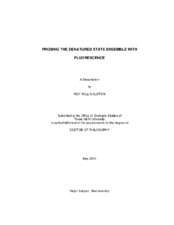| dc.description.abstract | To understand protein stability and the mechanism of protein folding, it is essential that we gain a better understanding of the ensemble of conformations that make up the denatured state of a protein. The primary goal of the research described here was to see what we might learn about the denatured state using fluorescence. To this end, tryptophan was introduced at five sites in Ribonuclease Sa (RNase Sa): D1W, Y52W, Y55W, T76W, and Y81W. The fluorescent properties of the denatured states of these five proteins were studied and compared to the fluorescent properties of eight model compounds: N-acetyl-tryptophan-amide (NATA), N-acetyl-Ala-Trp-Ala-amide (AWA), N-acetyl-Ala-Ala-Trp-Ala-Ala-amide (AAWAA), and five pentapeptides based on the sequence around the original tryptophan substitutions in RNase Sa. Regardless of the denaturant, λmax for the proteins and model compounds differed very little, 349.3 ± 1.2 nm. However, significant differences were observed in the fluorescence intensity at λmax (IF), suggesting that IF is more sensitive to the immediate environment than λmax. The differences in IF are due in part to quenching by neighboring side chains. More importantly, IF was always significantly greater in the protein than in its corresponding pentapeptide, indicating that the protein exerts an effect on the tryptophan, which cannot be mimicked by the pentapeptide models. Acrylamide and iodide quenching experiments were also performed on the model compounds and proteins. Significant differences in the Stern-Volmer quenching constant (KSV) were also observed between the proteins and between the proteins and their corresponding pentapeptides. Importantly, the KSV for the protein was always less than in its corresponding pentapeptide. These data along with the IF data show that non-local structure in the unfolded state influences tryptophan fluorescence and accessibility. In summary, these and our other studies show that fluorescence can be used to gain a better understanding of the denatured states of proteins. | en |


